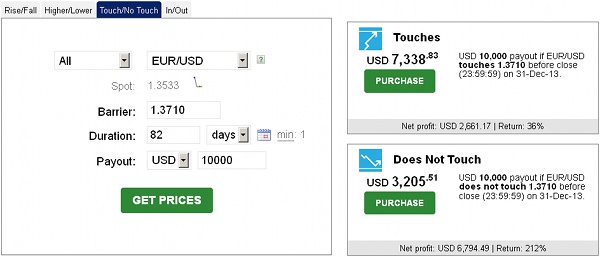
Contents
- 1 No-Touch Trade Opportunity
-
2 Protecting Against Risks
- 2.1 No hedge
- 2.2 Simple spot hedge without stop-loss
- 2.3 Simple spot hedge with stop-loss
- 2.4 Conditional spot hedge with stop-loss
- 3 Which Hedge Model to Choose?
- 4 My Trade
- 5 A Note on Swaps
- 6 Case Study Results
My recent poll gave me a hint of an interesting binary options trade — a
Usually, I do not trade binary options as the pricing is too high in my opinion. What I mean is that if you add prices of two opposite direction options (e.g. touch and
This case is rather different. First, I am, of course, not 100% certain that EUR/USD will not reach 1.3710 level by the end of 2013, but that level looks like a significant resistance for the currency pair. So the current price on

Protecting Against Risks
No hedge
You may decide to skip hedging part completely and risk your full stake to get $2 for each $1 risked in case EUR/USD does not reach 1.3710 during next 82 days. Here are the possible outcomes and your profit/loss for this case (here and on, I will use $100 contract as an example):
1. EUR/USD does not touch 1.3710 — you win and get $67 profit.
2. EUR/USD touches 1.3710 — you lose and book $33 loss.
Conclusion: simple, straightforward way to bet on an event. The option strike price (yellow line) and the major support level (red line) are marked but no hedging is visible on the chart below:
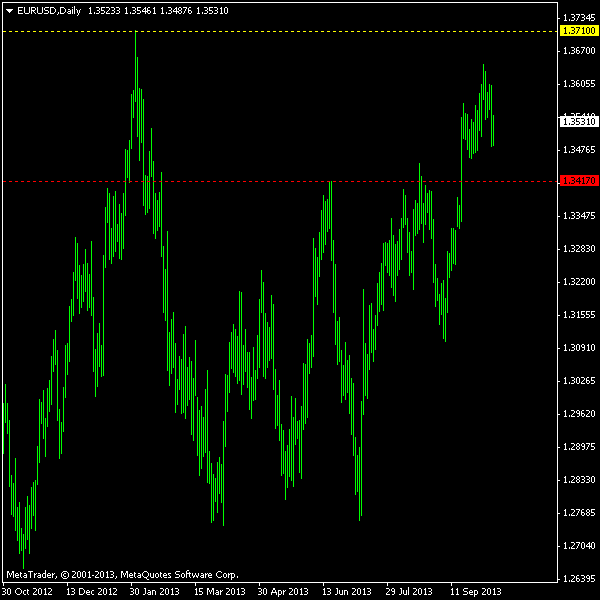
Simple spot hedge without
If losing $33 in case of a EUR/USD price hitting 1.3710 sounds too dangerous, you may decide to hedge your binary contract with a specially sized spot Forex transaction. Since we are aiming to compensate for case when EUR/USD goes up to 1.3710, we can easily say that we need a buy order with 1.3710
1. EUR/USD reaches 1.3710 during the period — binary options contract loses $33, spot position earns $33, net result: $0.
2. EUR/USD ends period above 1.3532 (hedge position entry level) and below 1.3710 without touching it — binary option contract yields $67 profit, spot position earns $0-$33 (18.54 cents per pip), net result: $67-$100 profit.
3. EUR/USD ends period below 1.3532 but above 1.3354 without touching 1.3710 level — binary option contract still yields $67 profit, but the spot position loses up to $67 (18.54 cents per pip), net result: $0–67 profit.
4. EUR/USD ends period below 1.3354 without touching 1.3710 level — binary option contract still yields $67 profit; spot position becomes a major loser with uncapped potential for loss (18.54 cents per pip), net result: $0-$∞ loss.
Conclusion: simple hedging with a single position and a single calculation routine — position size based on distance between current rate and option’s strike price. The perfect outcome here is when the price remains between 1.3710 (option strike) and spot position open level. The only losing scenario is EUR/USD finishing far below spot entry level, which still gets partially compensated by the binary option win. It can be recommended when you are confident that the market will be
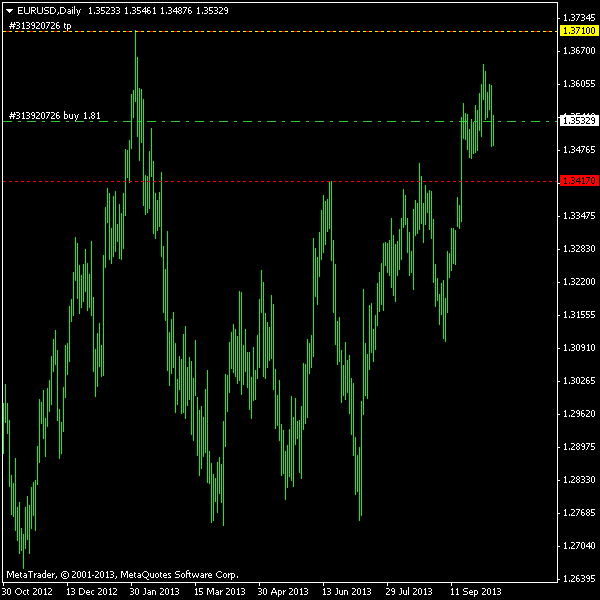
Simple spot hedge with
If you get a panic attack from thinking about unlimited loss that is possible in the previous scenario, you might want to lock your potential drawdown with a
1. EUR/USD reaches 1.3710 during the period before hitting SL — binary options contract loses $33, spot position earns $33, net result: $0.
2. EUR/USD ends period above 1.3532 (hedge position entry level) and below 1.3710 touching neither it nor SL — binary option contract yields $67 profit, spot position earns $0-$33 (18.54 cents per pip), net result: $67-$100 profit.
3. EUR/USD ends period below 1.3532 but above 1.3417 (SL) without touching 1.3710 level — binary option contract still yields $67 profit, but the spot position loses up to $21.32 (18.54 cents per pip), net result: $45.68-$67 profit.
4. EUR/USD ends period without reaching 1.3710, but having triggered SL — binary option contract still yields $67 profit; spot position ends with $21.32 loss (18.54 cents per pip), net result: $45.68 profit.
5. EUR/USD reaches SL first, then proceeds to 1.3710 — binary option contract results in $33 loss; spot position ends up with $21.32 loss (18.54 cents per pip), net result: $54.32 loss.
Conclusion: as you can see, there are 5 outcomes now. All but two lead to significant profit (compared to initial risk on binary option). One leads to zero gain. Only one outcome is really bad — when the price goes down to spot position’s SL first and then proceeds to a new yearly high. The loss there is more than double of the initial risk. How probable is such an outcome greatly depends on chosen SL and EUR/USD volatility during the period.
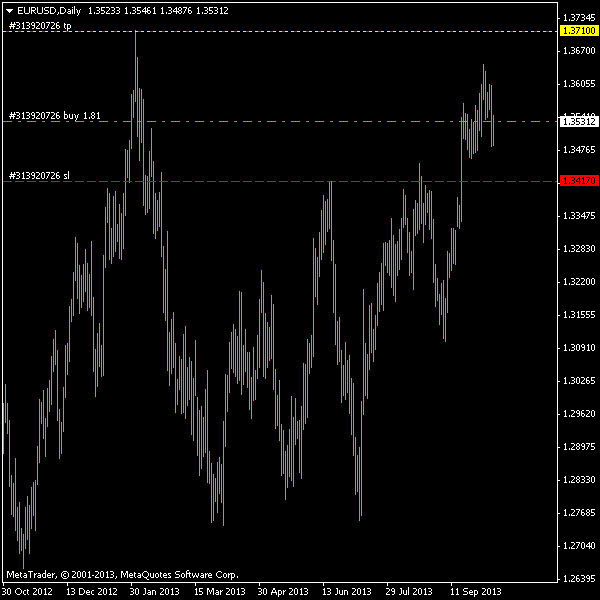
Conditional spot hedge with
If you really hate losing big amounts, you can consider adding a small twist to the SL hedge model — a conditional exit out of the binary option. The initial settings are the same as with the simple SL hedge model — TP, SL, position sizing and all. But now, since you can sell your
1–3. The first three outcomes are the same as in the previous model.
4. EUR/USD ends period without reaching 1.3710, but having triggered SL. Spot position results in $21.32 loss (18.54 cents per pip), but the binary option sale yields some profit. As the current EUR/USD price is now below your option entry price, its value can be anywhere between $33 and $100, which means $0-$67 profit. Net result: between $21.32 loss and $45.68 profit.
Conclusion: the new twist removes the previous worst outcome of $54.32 loss and adds an outcome with a rather undefined loss/profit situation. In fact, the farther your SL from your spot entry price and the less time left till binary option expiry the higher option’s selling price. There is one disadvantage with this hedging method — you have to sell the option contract manually unless your binary trading platform offers conditional sale on certain underlying price. It may be a difficult thing to do both physically (e.g. you are asleep when your SL is hit) and emotionally (e.g. you suddenly decide against selling your option).
Which Hedge Model to Choose?
It totally depends on two factors: your forecast for EUR/USD behavior and your risk tolerance:
My Trade
I will not be trading this position on live account, but instead I entered a virtual option trade and demo spot trade. I have used a $10,000 contract instead of a $100 one, so that hedging position could be entered with an exact sizing using hundredths of a standard lot. My exact
The MetaTrader screenshots that you see above are of my actual position. I will use the simple hedging model with
A Note on Swaps
82 days is a rather long term to hold an open foreign exchange position. Normally, your spot EUR/USD hedge position will incur swap payments for every day it is left overnight unless you are trading via
In reality, not all brokers calculate their rollover interest logically or fairly. I have opened my hedge position on Alpari demo account, and they charge $0.70 per standard lot to hold long position overnight (so that is -$1.27 per day for my case study example). They would be me paying $0.30 per standard lot for holding a short EUR/USD position. The good thing is that my loss on swaps will be small compared to the overall balance change caused by this hedged binary option trade. If I scale it down to $100 contract, it would be only $1.04 additional loss for 82 days, and the position could be closed by
On the other hand, my live account broker (EXNESS) offers $1.073 positive swap on long EUR/USD deals and $2.505 negative swap on short EUR/USD deals. If I decided to conduct this hedging case study with real money, I would be getting extra $1.94/day just for holding my hedge position open.
As you can see, swaps are worth paying close attention to when setting up a hedge position. You could be either earning some small additional income or losing slightly from them. In my opinion the former is a preferred choice in nearly all cases. By the way, did you notice an arbitrage opportunity that exists between Alpari and EXNESS swaps? But that is a completely different story.
Case Study Results
So today, on October 22, the EUR/USD currency pair has finally surpassed its previous maximum for 2013 and thus has finalized my case study research. The
Resulting EUR/USD chart:
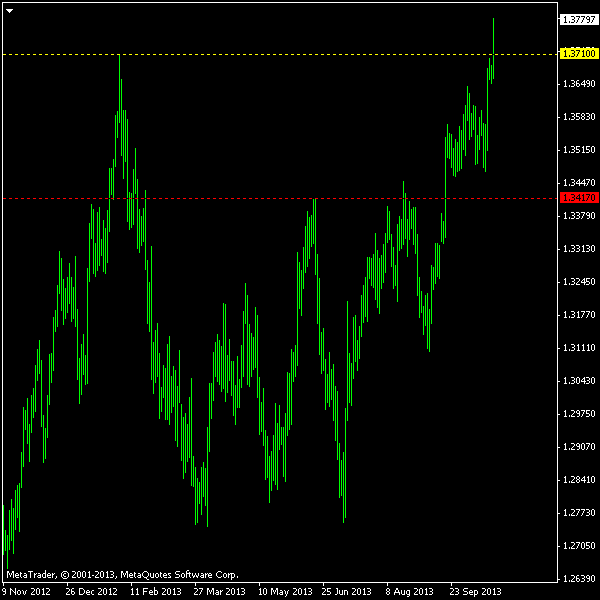
Disclaimer: The links to Binary.com used above are my own affiliate links. Here is a direct link to their website if you prefer: http://www.binary.com/. You may also try to find better trading conditions with other binary brokers.
Update 2013-10-11: Added a warning about swaps (overnight interest).
Update 2013-10-22: Added a case study results section.
Update 2013-10-31: You might be interested in this hedging calculator if you are serious about this trading technique.
If you have some questions about the proposed ways of hedging a binary trading position using a spot trade, please submit them using the commentary form below.